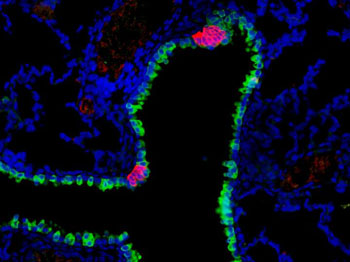Pulmonary Neuroendocrine Cells Function as Airway Sensors to Control Immune Response in the Lung
By LabMedica International staff writers
Posted on 24 Jan 2016
Researchers have found that pulmonary neuroendocrine cells (PNECs) sense environmental stimuli and transmit this information to the nervous system, which orchestrates an immune response in the lung.Posted on 24 Jan 2016
PNECs, which comprise only about 1% of the cells in the airway epithelium, occur in the lung as solitary cells or as clusters called neuroepithelial bodies (NEB). They are also located in the nasal respiratory epithelium, laryngeal mucosa, and throughout the entire respiratory tract from the trachea to the terminal airways. PNECs have been implicated in a wide range of human lung diseases, including asthma, pulmonary hypertension, cystic fibrosis, and sudden infant death syndrome, among others. Until now, their normal function in living animals was unknown.

Image: Pulmonary neuroendocrine cells (red) are rare cells found in clusters along the mammalian airway, where they act as sensors, sending information to the central nervous system. These clusters are found interspersed among other airway epithelial cells (green) (Photo courtesy of Dr. Leah Nantie, University of Wisconsin).
As part of a larger study on congenital respiratory disorders, investigators at the University of Wisconsin (Madison, USA) found that Roundabout receptor (Robo) genes were expressed in PNECs. In a mutant model, Robo inactivation in the mouse lung resulted in an inability of PNECs to cluster into sensory organoids and triggered increased neuropeptide production upon exposure to air. Excess neuropeptides led to an increase in immune infiltrates, which in turn remodeled the matrix and irreversibly simplified the alveoli.
The investigators stated in the January 7, 2016, online edition of the journal Science that they had demonstrated in vivo that PNECs acted as precise airway sensors that elicited immune responses via neuropeptides. These findings suggested that the PNEC and neuropeptide abnormalities documented in a wide array of pulmonary diseases may profoundly impact symptoms and progression.
"These cells make up less than 1% of the cells in the airway epithelium, the layer of cells that lines the respiratory tract," said senior author Dr. Xin Sun, professor of medical genetics at the University of Wisconsin. "In the mutant, they do not cluster. They stay as solitary cells, and as single cells they are much more sensitive to the environment. Our conclusion is that they are capable of receiving, interpreting, and responding to environmental stimuli such as allergens or chemicals mixed with the air we breathe."
Related Links:
University of Wisconsin













